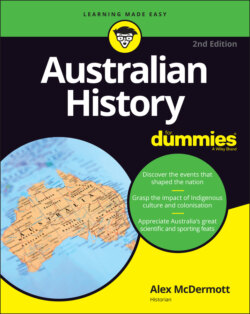Читать книгу Australian History For Dummies - Alex McDermott - Страница 12
Getting ahead in the convict world
ОглавлениеIf I say to you the words ‘convict colony’, certain mental images probably automatically flash up. Chances are, they’d be pretty grim ‘hellhole’-type images: A basic slave society with clanking chains and floggings.
Setting up a penal colony on the other side of the known world, with minimal chance of convicts returning to Britain once they’d served their time, certainly sounds like a recipe for disaster. But this is where the story of Australia gets interesting.
According to English law, criminals usually lost most of their legal rights after being convicted for a crime — and they lost them permanently. They couldn’t own property. They couldn’t give evidence in court. If the original colony planners or early governors had really been set on making life in NSW as miserable as possible for transported convicts, the scope was there. But that’s not what happened at all. In the new settlement, convicts not only kept their rights — they could own property, and could sue and give evidence in court — but they also became major economic players.
Convicts were allowed to retain legal rights and were given plenty of opportunities partly out of necessity: They were the vast majority of the population. How do you run a society where some 80 to 90 per cent of people can’t hold property or talk in court? Convicts were the labour force (and the police force!), and they were the tradesmen and a large chunk of the entrepreneurial class. If you wanted to get anything done in this strange new colony, you had to see a convict about it. Indeed, if you wanted a date, you needed a convict. Most of the soldiers and officials had come out without womenfolk. While the soldiers and convict women entered into common-law partnerships (or de facto marriages), plenty of officers had relationships where convict women were their lovers and mistresses, sometimes even setting them up in businesses, having families and children with them, and occasionally even marrying them.
Economically, the new colony offered plenty of opportunities to make money, especially in importing and exporting — and, most notably, trading in alcohol for a very thirsty populace. Military officers, convicts and ex-convicts were all quick to get in on the act. None of them was super-scrupulous about how they did it, either.
By a weird quirk of fate, which neither transportation’s administrators nor its detractors wanted publicised too much, getting caught, convicted and transported for crimes committed in Britain in the late 18th or early 19th centuries was frequently the luckiest break a criminal ever scored. (See Chapters 4 and 5 for more on the opportunities and second chances offered to new arrivals in NSW.)
Eventually, Britain got around to designing and building proper convict hellholes — at Port Arthur, Norfolk Island, Moreton Bay and Macquarie Harbour (see Chapter 6). But that took decades, and life in these places was never the reality for the majority of convicts.
The myth of NSW as a convict hellhole was at least in part a creation of free settlers. In the 1840s, plenty of now successful free settlers wanted to separate their new home from the stigma of convict association, so they dwelt on the horror of the exceptional places and practices — the chain-gangs, the isolated outposts designed for severe punishments — as if they were the usual thing. They weren’t. But they created a myth that still shapes our thoughts about convict life.
